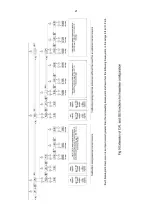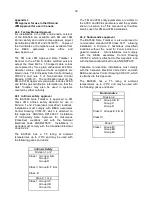
10.2.4 Alarm enable: ‘EnbL’
This function allows each alarm to be enabled or
disabled without altering any of the alarm
parameters. To enable or disable the alarm select
'EnbL' from the alarm menu and press
P
which will
reveal the current setting ‘on’ or ‘oFF’. The
function can be changed by pressing the ▲ or ▼
button followed by the
E
button to return to the
alarm menu.
10.2.5 Type of alarm: tYPE
This function conditions the alarm to operate on
the rate or total display. Alarm 1 and Alarm 2 may
both be rate or total alarms, or one may be
conditioned for rate and the other for total.
To check or change the type of alarm, select 'tYPE'
from the alarm menu and press
P
which will reveal
the current setting. The function can be changed
by pressing the ▲ or ▼ button followed by the
E
button to return to the alarm menu.
Note:
When the ‘tYPE’ function is changed all
associated alarm functions are reset to default
conditions.
10.2.6 Setpoint adjustment: ‘5Px1’ and ‘5Px2’
The setpoint of each alarm may be positioned
anywhere in the numerical display of the selected
rate or total display.
The setpoint identification changes depending on
the type of alarm. If the alarm has been
conditioned by the ‘tYPE’ function to operate on
the rate display the setpoint will be identified as
‘5Pr1’, if operating on the total display it will be
identified 5Pt1.
To adjust the setpoint select '5Px1' or '5Px2' from
the alarm configuration menu and press
P
which
will reveal the existing alarm setpoint. The flashing
digit of the setpoint can be adjusted using the ▲
and ▼ push buttons, and the
P
button to move
control to the next digit. When the required
setpoint has been entered press
E
to return to the
alarm configuration menu.
The alarm setpoints may also be adjusted when
the Rate Totaliser is in the display mode, see
section 9.3.13.
10.2.7 Alarm function: ‘Hi.Lo’
Each alarm can be independently conditioned as a
high alarm or as a low alarm. To check or change
the alarm function select 'Hi.Lo' from the alarm
menu and press
P
to reveal the current setting.
The function can be changed by pressing the ▲ or
▼button followed by the
E
button to return to the
alarm menu.
10.2.8 Alarm output status: ‘no.nC’
Configures the solid state alarm output to be open
‘no’ or to be closed ‘nC’ in the non-alarm condition.
When deciding which is required, care should be
taken to ensure that the alarm output is fail safe as
illustrated in Fig 10.
‘no’ Alarm output open in non-alarm condition
‘nC’ Alarm output closed in non-alarm condition
CAUTION
When the 4/20mA supply is removed
from the loop powered Rate Totaliser,
both alarm outputs will open irrespective
of configuration. Therefore for fail safe
operation both alarm outputs should be
configured to be open in the alarm
condition ‘nC’.
To check or change the alarm output status, select
'no.nC' from the alarm configuration menu and
press
P
to reveal the setting. The function may be
changed by pressing the ▲ or ▼ button followed
by the
E
button to return to the alarm configuration
menu.
10.2.9 Hysteresis: H5tr
Only functions on rate display
Hysteresis is shown in the units that the rate
display has been calibrated to display.
To adjust the hysteresis select 'H5tr' from the
alarm menu and press
P
which will reveal the
existing figure. The flashing digit can be adjusted
using the ▲ and ▼ push buttons, and the
P
button will move control to the next digit. When the
required hystersis has been entered press
E
to
return to the alarm configuration menu.
e.g. A BA354E calibrated to display a rate of 0 to
10000, with a high alarm set at 9000 and
hysteresis of 200 will perform as follows:
The high alarm will be activated when increasing
rate display equals 9000, but will not reset until the
rate display falls below 8800.
10.2.10 Alarm delay: dELA
This function delays activation of the alarm output
for an adjustable time following the alarm condition
occurring. The delay can be set in 1 second
increments between 0 and 3600 seconds. If a
delay is not required zero should be entered. To
adjust the delay select 'dELA' from the alarm
configuration menu and press
P
which will reveal
the existing delay. The flashing digit of the delay
can be adjusted using the ▲ and ▼ push buttons,
and the
P
button to move control to the other digits.
When the required delay has been entered press
E
to return to the alarm menu.
32
















































